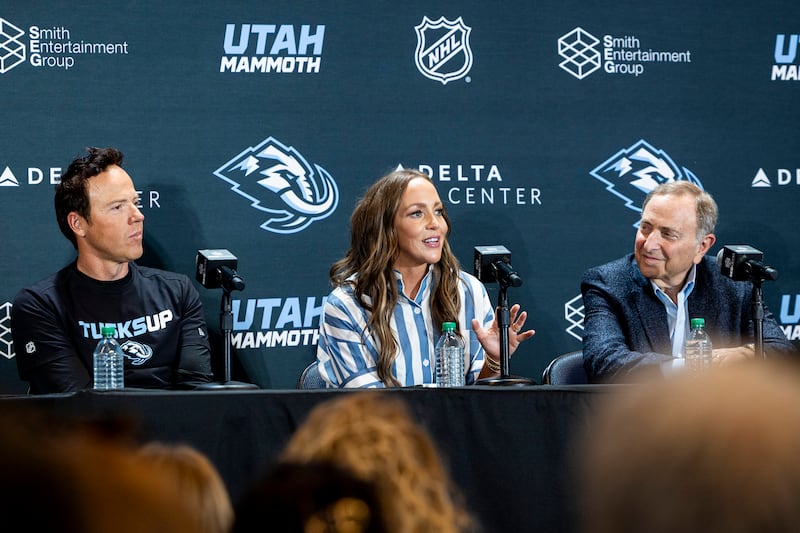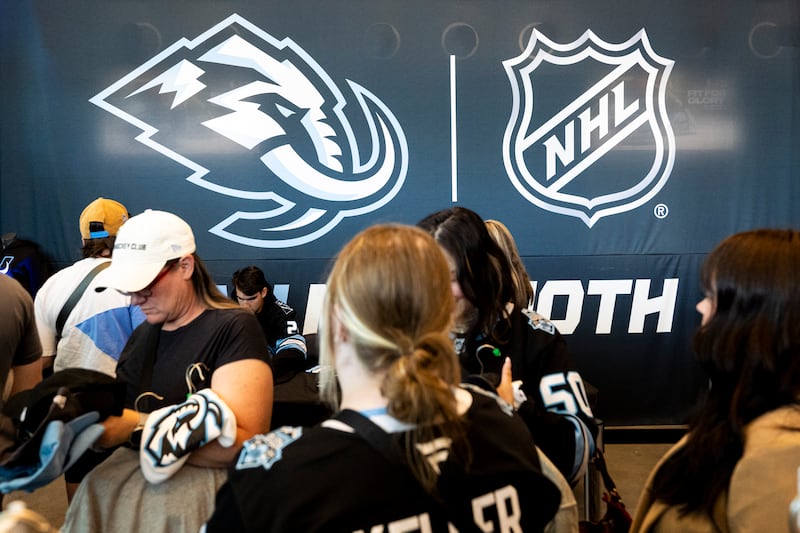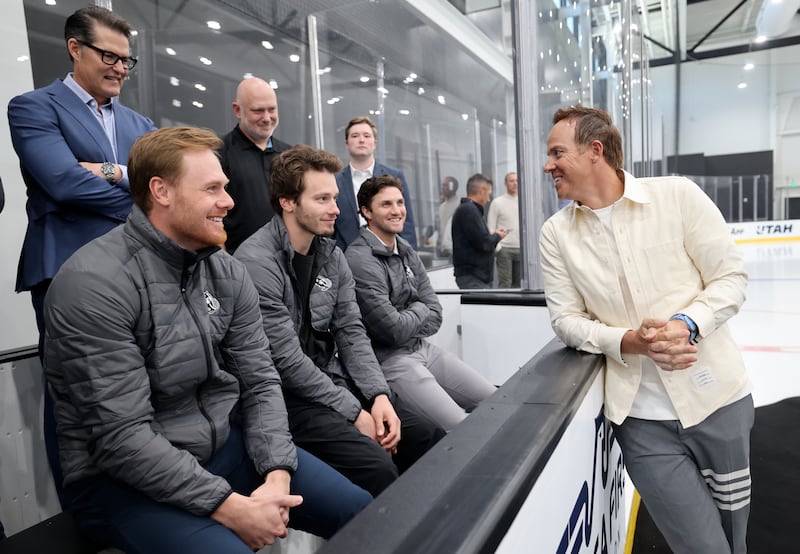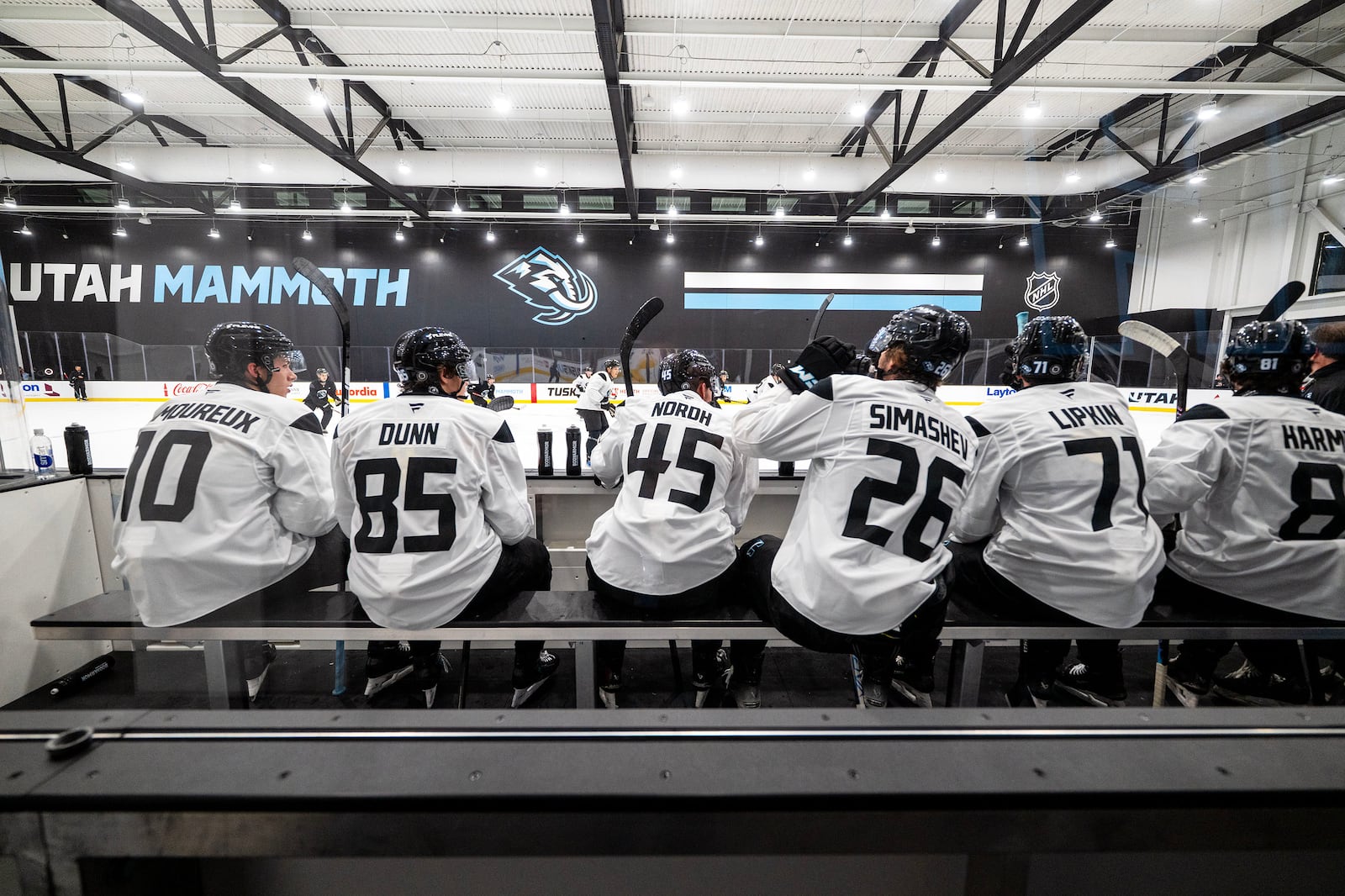This story appears in the October 2025 issue of Utah Business. Subscribe.
At this time last year, Utah’s relationship with the National Hockey League felt like a Tinder date. Its profile looked promising, and we looked compatible on paper — but really, we were just getting to know each other.
We learned that Utah’s new hockey team had a red-bearded Canadian named Liam O’Brien who, at the Delta Center welcome event, told us to call him “Spicy Tuna.” And we did.
We discovered we had a talented goalie named Karel Vejmelka. When he made a remarkable 49 saves in a memorable 4-1 win against the Carolina Hurricanes last November, we chanted “Veggie” at the top of our lungs, which, naturally, led to fans showing up at games wearing broccoli hats.
On October 15, when the franchise’s second season opens at a renovated Delta Center, we’ll find out where the relationship between Utah and the team we now call the Mammoth goes from here.
Hockey FOMO and the Vegas blueprint
Tyson Nash played seven years in the NHL and now hosts “NashCast,” a no-holds-barred alternative game broadcast that features interviews and storytelling. Nash considers himself Utah’s ambassador of hockey.
“So much has changed since last year,” Nash says. “They’re a team that believes now. They’re a team that has fans behind them, and has ownership behind them that wants to spend money, and I think that changes everything. … Talk to anyone around the league who watches hockey, and they’ll say this is a team on the rise.”
For the Mammoth, the Vegas Golden Knights are the case study for how a city can fall head-over-heels in love with a hockey team. Vegas shocked the NHL by making it to the Stanley Cup Finals in its first season in 2017. In 2023, it won the Stanley Cup and paraded it down The Strip as a raucous crowd of 200,000 celebrated. The team has sold out every game it has ever played.
That excitement for hockey in Vegas has translated into more sponsorship deals than any other NHL franchise, according to SponsorUnited, and that’s despite playing in the league’s second-smallest market. Vegas’ franchise value has grown 270 percent over its first eight years, from the $500 million purchase price to $1.85 billion.
“Vegas really is the gold standard for going from zero to most engaged in a community that had no hockey,” says Joe Favorito, a sports business professor at Columbia University and long-time sports executive. “Not only didn’t they have hockey, they didn’t have ice. … You’re creating an experience at the end of the day that everybody wants to be part of, not just hockey fans. You want to create unbelievable FOMO [fear of missing out].”
Owners Ryan and Ashley Smith and the Smith Entertainment Group (SEG), the engine that powers community-building for the Jazz and Mammoth, see professional sports as a platform for, in Ashley’s words, unifying the community “in a world that’s very, very divisive.”
“I tell people from the outside when they ask me about Utah — and I do think we’re a unicorn this way — that the intersection of faith, enterprise and government here is quite unusual,” says Chris Barney, SEG’s president of revenue and commercial strategy. “We have a collective energy to make Utah the best place to live, the best place to raise a family, the best place to do business. All of those things really matter to us.”
How, then, will the Utah Mammoth make us fall in love with professional hockey? The team is leaning into five strategic pillars that extend well beyond game nights.

1. Make the new state-of-the-art practice facility in Sandy a hub of fan interaction.
As Mammoth Team President Chris Armstrong remembers, it wasn’t long after Utah’s new hockey team was introduced at the Delta Center that he and other team executives hit the road. Their mission? Find the best examples of training facilities across all of North America.
“Not just NHL facilities, but NFL facilities, MLB facilities, and the like, to really establish for ourselves what we think is best in class,” Armstrong says. “The unique opportunity for us is that we’re building from the ground up. The vision started to take shape based on that field research.”
That vision turned into a 115,780-square-foot training facility and team headquarters located at The Shops at South Town mall in Sandy. It includes two NHL-standard ice surfaces, locker rooms for the Mammoth and visiting teams, a player’s lounge, multiple gyms, medical facilities for treatment, hot and cold tubs for recovery and an infinity pool.
Clayton Keller, the Mammoth’s team captain, told reporters after his first tour of the facility that it is, “Top three, top five in the league for sure.”
Having one of the most modern headquarters in the league checks a few boxes. It sends a message to the NHL’s best free agents that Utah is serious about winning. Youth hockey teams will have the opportunity to play there, which Armstrong hopes will “inspire the next generation of kids in Utah to play the game of hockey.” And fans will be welcome to watch practice at the Sandy facility.
“I would say it’s going to be the No. 1 place that our fans interact with the team and the brand of the Utah Mammoth,” Armstrong says. “More people will come through that facility in a year than will come through the Delta Center.”
Work is also being done to make the Delta Center a better venue for hockey. That’s important because the NHL relies on ticket sales for 44 percent of its revenue, compared to 17 percent for the NFL and 26 percent for the NBA.
In its inaugural season, the Delta Center had just 11,000 seats with unobstructed views, making it the NHL’s smallest venue. On weekends and for popular opponents, it would open up another 4,000 to 5,000 limited-view seats, but hockey is a lot more fun when you can see both nets. As soon as hockey season ended, SEG began a three-year renovation that will eventually enable the Delta Center to seat 17,000 fans for hockey.
2. Find storytellers who understand the assignment and cast those stories across multiple media channels to reach new audiences.
It’s Mammoth Week, a summer barnstorming tour of seven Utah cities, and Nash is standing outside Park City Ice Arena. He just came off the ice, where he was part of a youth hockey clinic, and now he’s checking messages.
A couple of young fans walk by and one of them shouts, “Love the NashCast, man!”
The NashCast on SEG’s streaming service is modeled after the popular ManningCast (featuring former NFL stars Eli and Peyton Manning) that ESPN runs alongside Monday Night Football. Nash and NHL insiders share anecdotes and debate big plays, creating an experience that is a lot like watching the game with friends.
Nash says Ryan Smith got the idea after a round of golf, when he, Nash and other players gathered around a big round table at the grill and swapped stories.

“He’s like, ‘These are the best stories I’ve ever heard,’” Nash recalls. “I think that resonated with him in that moment. He is constantly thinking of ways to give fans any and every chance to digest our game.”
Smith peppered Nash with video clips all summer until Nash agreed to test the concept. It ran throughout the first season, turned into a weekly podcast in the offseason, and will return when the Mammoth opens its new season in Colorado.
“Honestly,” Nash says, “I was scared to death. And now it’s morphed into a podcast, and it’s probably been the best thing that ever happened to me. It’s a totally different way to watch the game.”
Matt McConnell is the voice of the Mammoth, and educating fans about NHL hockey is not a new assignment for him. In his first NHL gig, he served as the radio play-by-play announcer when the Anaheim Ducks entered the league in 1993, and he was at the microphone when the Atlanta Thrashers (now the Winnipeg Jets) entered the league in 1999. He calls the opportunity to help Utah build a new fan base a “personal renaissance.”
“When we got here, we were trying to figure out if it was going to be Hockey 101 or Hockey 201,” McConnell says. “You really need to figure out what fans want to know, and you adapt and you adjust as you cover the team.”
McConnell and the team received validation when a recent survey in The Athletic ranked the Mammoth broadcast team one of the top three in the NHL. “Utah’s broadcast drew rave reviews for achieving the impossible task of educating new fans without alienating avid hockey fans,” the report said.
3. Cultivate the next generation of fans by supporting youth hockey programs and building more rinks.
As much as Salt Lake City is a winter sports mecca, more kids here have been raised to send it on snow than to skid around on frozen water.
When the curtain rose on Utah’s first NHL game, the state had just 13 year-round ice rinks, just six Utah natives who had ever worn an NHL uniform, and not a single university competing at an NCAA Division 1 level.
Mark Newman founded Orem-based Nomi Health in 2019 with a mission of making healthcare more accessible through technology, and he and his team jumped at the chance to support the Mammoth’s efforts to make hockey more accessible for kids.
Nomi sponsors three key initiatives — the Hockey 101 program, which teaches young athletes how to play hockey; another program that helps physical education teachers integrate hockey into gym class, with funds for equipment like sticks, helmets and nets; and an initiative that makes 222 tickets available to schools and community organizations for each of the Mammoth’s 41 home games.
According to Barney, more than 10,000 kids have already participated in a Hockey 101 program.
“The Hockey 101 program and our ticket sponsorships are about giving back to the Utah community, removing barriers and creating opportunities for kids and families to experience the sport for the first time,” Newman says.

Owner Ryan Smith gave the youth hockey initiative another big boost in March, announcing that SEG would donate up to $10 million to help entrepreneurs and municipalities in Utah build 20 new hockey rinks.
Mammoth General Manager Bill Armstrong said at a press conference before the first season that the most important way to build a Utah hockey culture is to win. “That usually inspires them in masses. That’s the first part of it,” he continued. “Building rinks is probably the second part of it.”
4. Line up A-list corporate partners who help create memorable experiences that are bigger than the game.
Morgan Marietti founded the University of Utah’s women’s hockey club team in 2018 and became its first head coach, one of many ways she has inspired women and young girls all across Utah to pursue the sport.
At age 32, she was diagnosed with synovial carcinoma, a soft tissue cancer that was found in her lungs. She was there at the Delta Center in January for Hockey Fights Cancer, a game-night event sponsored by University of Utah Health and the Huntsman Cancer Institute (HCI). The hockey team introduces and honors cancer patients and survivors, who drop the ceremonial pre-game puck, watch warmups from the bench and ride the Zamboni.
Marietti, now cancer-free and the associate director of cancer center partnerships at the American Cancer Society, was honored along with her mother, Diane, a breast cancer survivor and one of the first patients ever treated at HCI.
“Growing up as a hockey player in Utah, I never imagined that the skills I learned on the ice would translate to skills I needed during cancer treatment,” Marietti says in a University of Utah Health event report. “The hockey community is family, no matter the fight.”
Hockey Fights Cancer is exactly the kind of community-building partnership the Utah Mammoth seek out, according to Barney.
“Utah companies aren’t just stepping up and buying TV spots from us and buying signs,” he says. “We really want to use the platform to create meaningful opportunities in the community. And our partners really lean into that.”
5. Win.
Nothing strengthens the bond between a city and a team like a run through the Stanley Cup playoffs.
The Tampa Bay Lightning joined the NHL in 1992 and has made it to the Stanley Cup Finals five times, winning the Cup in its 12th season, then winning back-to-back in 2020 and 2021. The Lightning have sold out a remarkable 414 consecutive home games.
On the other hand, the Columbus Blue Jackets joined the NHL in 2000, and they’ve missed the Stanley Cup playoffs in 19 of their 25 seasons. So it should be no surprise that Columbus ranks last in valuation and revenue generation and infrequently sells out its home arena.
Chris Armstrong believes the Mammoth have assembled a compelling team of young, high-energy players who should be lightning fast and fun to watch.
The Mammoth will be one of the youngest teams in the NHL, and they signed several of their brightest stars to long-term contracts — their 27-year-old leading scorer Keller, signed through 2028; their 29-year-old goalie Vejmelka, signed through 2030; their new goal scorer, 23-year-old JJ Peterka, who signed a contract through 2030 after being acquired from the Buffalo Sabres; and promising 22-year-old forward Dylan Guenther, signed all the way through 2033.
“We are all hypercompetitive individuals who want to win,” Armstrong says. “I think it’s finding a balance between the right culture and the right infrastructure as an organization for that winning to be sustainable. … The other side of that is going for a winning-at-all-costs mentality, where you go for one championship and then pick up the pieces. That’s a hard environment for an athlete.”
McConnell, entering his 29th NHL season, believes fans will see a team hungry to make the playoffs after falling seven points short of the St. Louis Blues for the final spot in the 2025 Stanley Cup playoffs.
“I think the team on the ice is going to be better than they were last year,” McConnell says. “They’ve got an unbelievable nucleus of talent, a bunch of 20-somethings that will bring you out of your seat every night. … I fully anticipate this team knocking on the door for a playoff spot next spring.”
Bleacher Report agrees, predicting that the Mammoth will make the Stanley Cup playoffs.
As the puck drops on a new season, one thing is clear: Utah’s Mammoth love story is just getting started.

